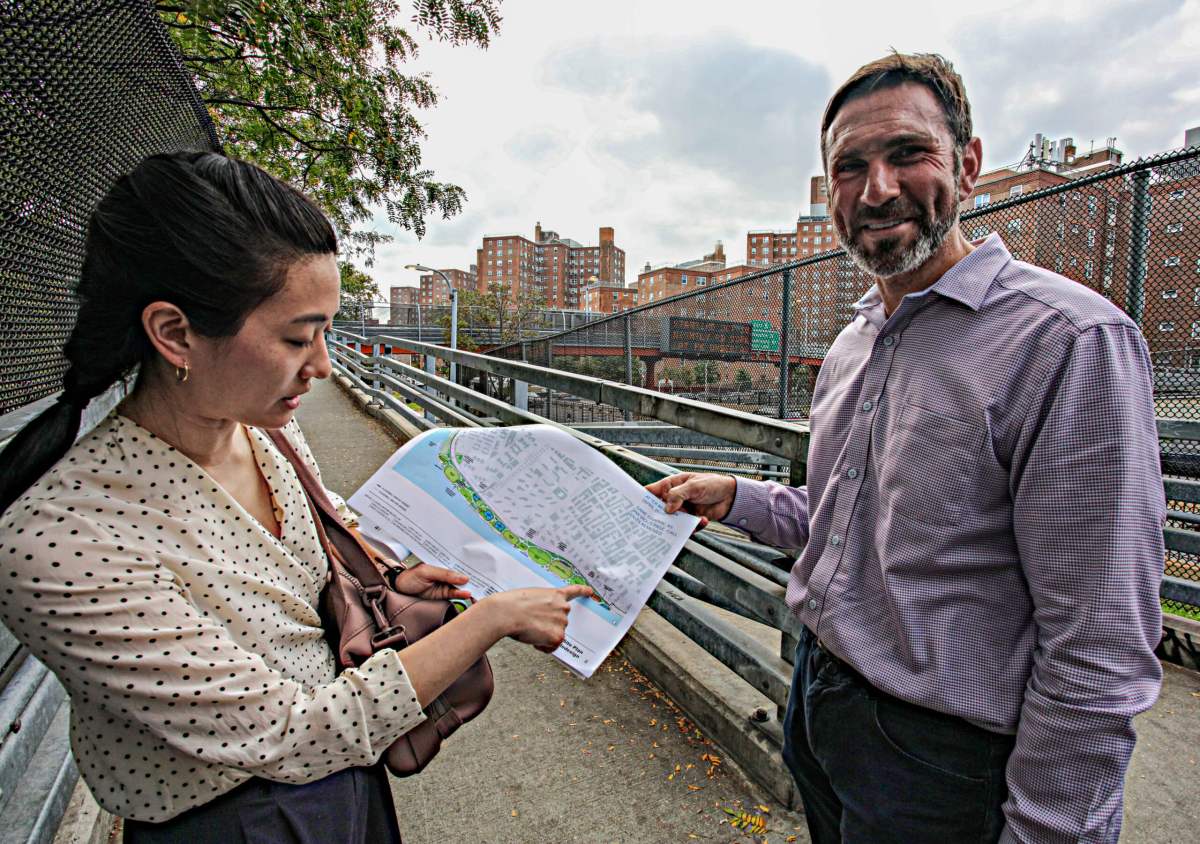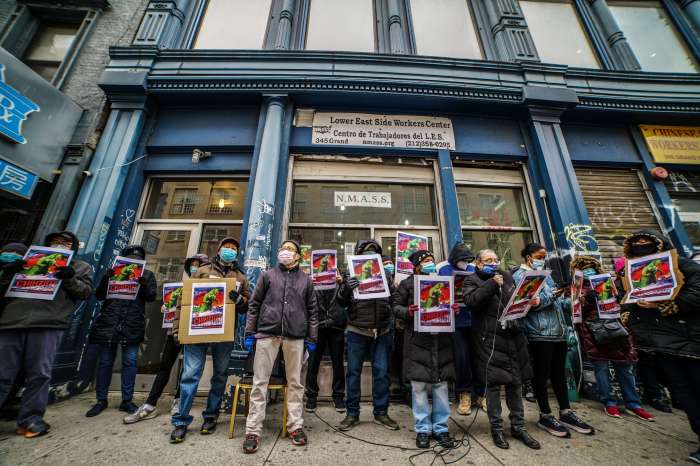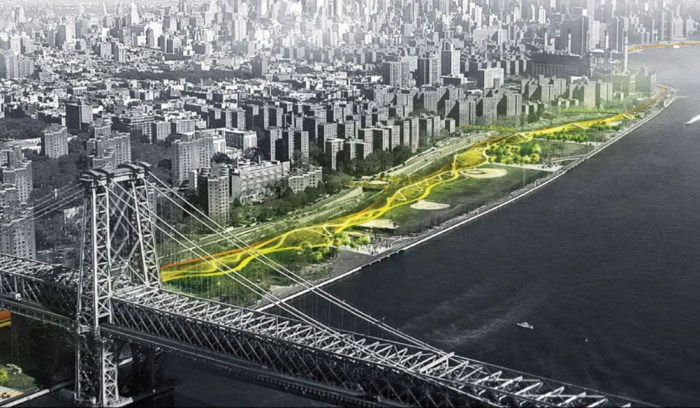The Department of Design and Construction (DDC) and the Parks Department recently took amNewYork Metro on a tour of the East River Park construction areas where the agencies externalized their plan for a grander greenspace that will also double as greater protection for the Manhattan waterfront.
“Welcome to the largest and most ambitious urban climate adaptation project in the world,” Commissioner of the City’s Design and Construction Jamie Torres-Springer said as he pointed to the aging, flaking footbridge that takes pedestrian traffic over the FDR Drive and into East River Park. “No more zigzagging,” he added, describing the easy new way New Yorkers will one day be able to access the bridge.
This overpass is but one of many new amenities both the DDC and the Parks Department are touting as improvements that will come as a result of the East Side Coastal Resiliency (ESCR) Project, a $1.4 billion plan that would reconstruct approximately 57 acres of coastal parkland from East 25th Street to Montgomery Street.
“We’ve got this project completed in the design and bided out so that we are ready to start construction in East River Park this fall. We’ve also started construction in the Northern part of the project where you can see we’ve already built 500 feet of the flood wall,” Torres-Springer said, describing the area near Stuyvesant Cove Park along the East River. Sheet piles were installed in this wall construction along with large steel beams creating both a strong anchor that protects against water infiltration.
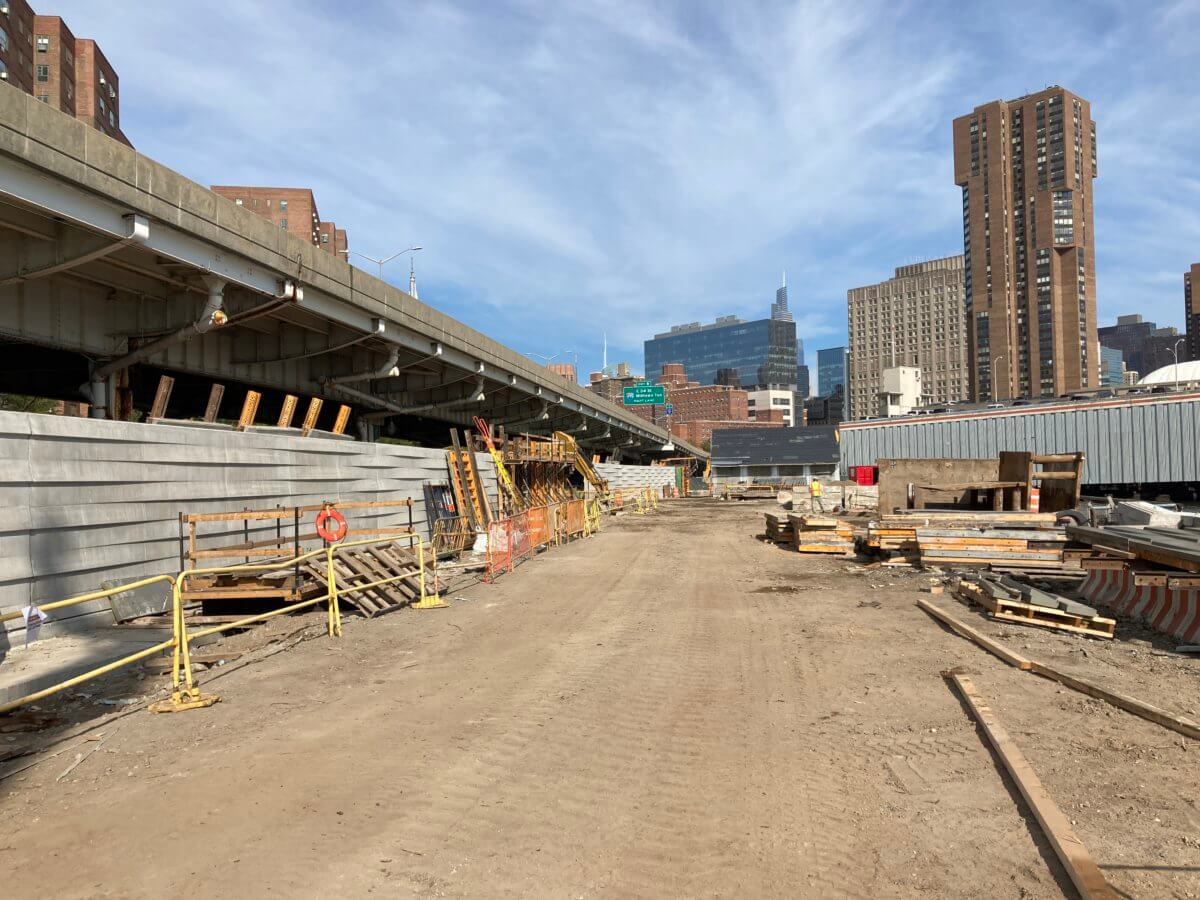
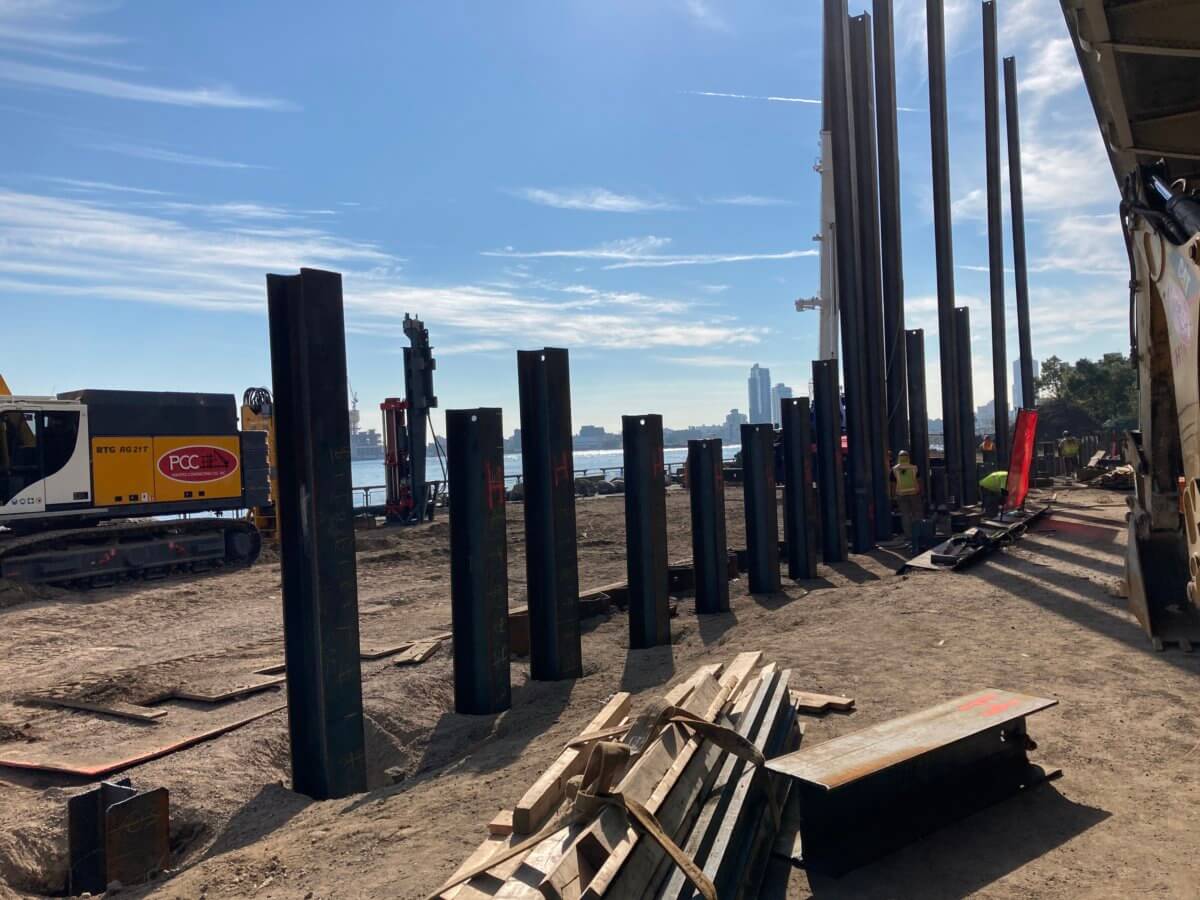
This longstanding and embattled project to protect the Lower Manhattan area from climate change hasn’t been smooth sailing for the proponents, in fact, construction has faced several setbacks due to the global COVID-19 pandemic, design revisions, and pushback by those who would rather the land remain undisturbed with a less invasive plan that was overturned in 2018.
However, now, as work is finally set to begin this fall, top agency officials say they believe the plan is in the best interest of New Yorkers.
“It makes a lot of sense to us to ensure this really valuable neighborhood amenity can continue to be here into the future as sea levels rise and that we don’t lose it to floods,” Alda Chan, director of resiliency at the NYC Parks Department, told amNewYork Metro.
Both Torres-Springer and Chan say the 2012 superstorm Sandy’s devastation of the Lower East Side served as the catalyst for the ESCR, affecting more than 110,000 local residents, including 28,000 who live in public housing. In order to prevent future power loss, flooding, and other issues caused by storm surges and heavy rainfall—which has been further induced due to climate change—the ESCR will include a flood wall, moveable floodgates, improving the sewage drains, and reconstructing the entire recreation areas.
“By raising the park, we are not really touching the fill that’s under the existing park, which is fill from a historic period. Of course, any time you touch it you are very careful with it. We will be bringing in new fill, and that fill is heavily regulated by local, state, and federal environmental regulations in terms of being clean,” Torres-Springer said.
DDC is particularly proud of the flood wall, which the agency says will be invisible thanks to it being erected underneath new soil, which will raise the park by eight feet. They affirm this will prevent residents from suffering from obscured views or the sight of ugly walls.
“We really saw the devastation that storms like Hurricane Sandy had across our waterfront parks,” Chan said, sharing that the Parks Department had to remove 20,000 trees after the 2012 hurricane, and 11,000 trees were removed solely due to saltwater inundation with 258 removed in East River Park.
One of the many arguments made against the ESCR plan by protest groups such as East River Park Action is concern over further removal of some 1,000 trees which is expected during the construction process, along with environmental concerns brought by the fill which will be used in the process to raise the parkland.
For years, protesters have held rallies throughout Lower Manhattan with demonstrators chaining themselves to trees at City Hall demanding construction be stopped.
Both Chan and Torres-Springer say they take these concerns seriously.
“Our waterfront parks, like East River Park, are seeing a lot of risk and decline post-Sandy. It’s been a number of years now, but our tree canopy hasn’t fully bounced back,” Chan said, adding that the Parks Department plans on planting over 1,800 trees—nearly double what is in the park now—as well as including diverse species of plants (over 50).
Additionally, a complete inventory of all the plant beds have been made and those that can be successfully transplanted will be placed in local parks. Chan also shared that they will be working with a vendor who focuses on wood reuse and salvage for the trees removed from East River Park.
While construction has heavily begun at the 2.44-acre Asser Levy Playground, it is one of many recreational areas that will see vast improvements beyond simply making the area more resilient to water damage.
Park access has been another argument made by those who oppose the ESCR plan, stating the need for open greenspace is greater now more than ever, especially during the COVID-19 pandemic.
“We’ve been able to phase this plan so that there’s always about half of East River Park open at any given time during construction. We’re working right now as we finalize the phasing plan on what will close and what will be open and how you will you access things will be out in a few weeks,” Torres-Springer said, adding that the Parks Department has made improvements to local courts and fields across the Lower East Side so that individuals have a place to go during the construction period.
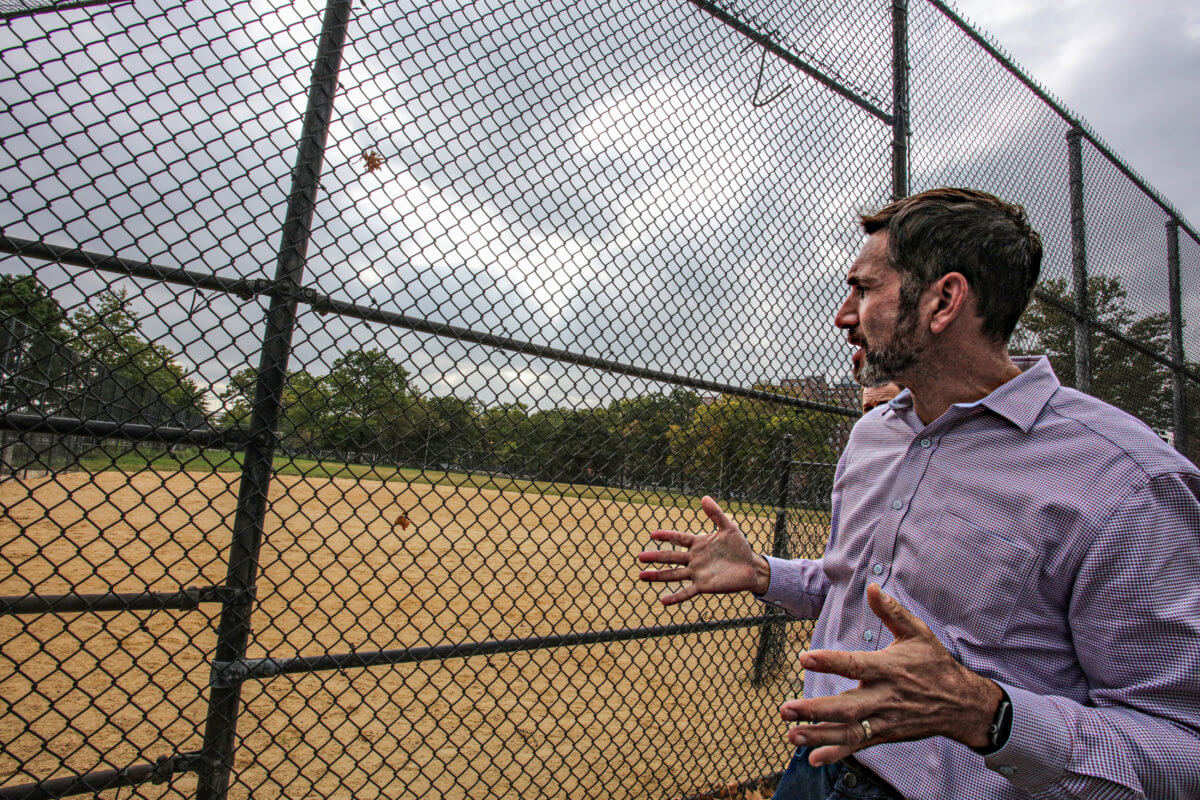
He added that barbecue pits, restrooms, track fields, baseball fields, courts, and other areas have not received needed renovations over the decades. Believing that the ESCR plan will provide residents a world class park that they deserve, Torres-Springer says that there has been a long community engagement process holding over 200 meetings.
Opponents against the ESCR plan feel differently regarding transparency, underscoring that in March 2021 after months of FOIL requests, they fought to review a “Value Engineering Study,” which was conducted in 2018. However, when the report was released, it was heavily redacted. It wasn’t until April that a more readable version was released.
“We’re rebuilding all of those ballfields and courts for community use, and they will be much improved because they have been under-invested in over the years. Also, a park for today needs more than ballfields and courts. There aren’t very many lawn spaces for people to sit, look out at the waterfront and spend time with family and friends. We’re going to have much more passive recreations with barbeque pits incorporated into it, more playgrounds, and play areas for kids. That’s all a part of the new plan and it’s not part of the existing East River Park. This is really about improving East River Park to serve local residents who really deserve a world class park,” Torres-Springer said.
While there continues to be protests against this project, it is projected to be completed in 2026 after several delays, including lawsuits and the COVID-19 pandemic
In a response to this, East River Park activists, Eileen Myles and Sarah Wellington say they don’t believe the ESCR plan is the best option to reinvigorate the parkland.
“We don’t call annihilating a park a renovation,” the advocates shared, adding that scientist members in their organization believe the trees would have a long future.
“ESCR is dangerous. By tearing down our only park and its 80-year-old trees that mitigate the effects of climate change lower Manhattan will be less safe and have less resiliency in the future than we do now,” Myles and Wellington stated in a statement.



